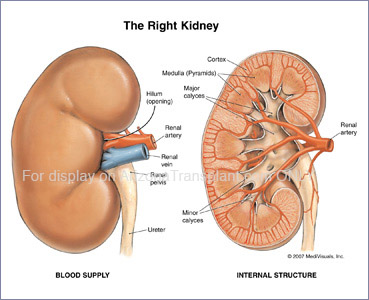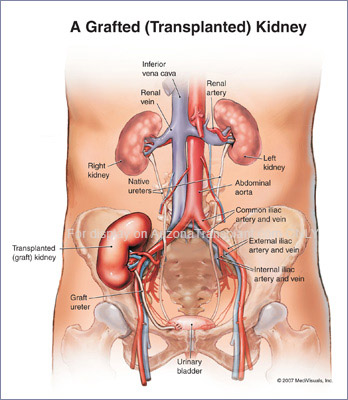About the Kidneys
The kidneys are bean-shaped organs in the abdomen of the human body. The kidneys filter wastes from the blood and excrete them, along with water, as urine.
There is one kidney on each side of the spine. The right kidney sits just below the liver. The left kidney sits below the diaphragm and next to the spleen. They are surrounded by two layers of fat which help cushion them.
Volume
From 2007 - 2021, Arizona Transplant Associates have performed this volume of kidney procedures.
Why are kidneys important?
The most important function of the kidneys is the removal of waste products produced by metabolism. They also assist in homeostasis of the body by regulating the balance of ions and water in the blood.
Additionally, the kidneys help maintain a person's blood pressure. When blood pressure becomes low, the kidneys secrete an enzyme called Renin that increases water absorption and blood volume which raises the blood pressure.
The kidneys also secrete a variety of necessary hormones including erythropoietin, urodilatin and vitamin D.
Kidney Disease
People can have two types of kidney disease: congenital, which exist from birth, or acquired, which develop over time. Most patients that visit Arizona Transplant Associates have acquired and chronic kidney diseases. The two main causes of chronic kidney disease are diabetes and high blood pressure, which are responsible for up to two-thirds of the cases. According to the National Kidney Foundation, 20 million Americans, 1 in 9 US adults, have chronic kidney diseases. Another 20 million are at increased risk.
Congenital disease include:
- Congenital hydronephrosis
- Congenital obstruction of urinary tract
- Duplicated ureter
- Horseshoe kidney - Horseshoe kidney affects about 1 in 500 to 1 in 600 people. The persons two kidneys fuse together to form a horseshoe-shape. This is the most common type of fusion anomaly in the kidneys.
- Polycystic kidney disease - A person with polycystic kidney disease has multiple cysts in both kidneys. Symptoms include high blood pressure, fatigue, mild to severe back pain and urinary tract infections.
- Renal dysplasia
- Unilateral small kidney
Acquired diseases include:
- Diabetic nephropathy
- Glomerulonephritis
- Hydronephrosis is the enlargement of one or both of the kidneys caused by obstruction of the flow of urine.
- Interstitial nephritis
- Kidney stones are a relatively common and particularly painful disorder.
- Kidney tumors
- Lupus nephritis
- Minimal change disease
- In nephrotic syndrome, the glomerulus has been damaged so that a large amount of protein in the blood enters the urine. Other frequent features of the nephrotic syndrome include swelling, low serum albumin, and high cholesterol.
- Pyelonephritis is infection of the kidneys and is frequently caused by complication of a urinary tract infection.
- Renal failure
Treatments Provided for Kidney Disease
by Arizona Transplant Associates
Doctors Cashman, Brink, Van der Werf and Chaly offer the following kidney procedures:
- Laparoscopic nephrectomy - The kidney is removed using laparoscopic instruments under general anesthesia. Small one inch incisions are made in the patient's abdomen.
- Kidney resection - A portion of a person's kidney is surgically removed usually because they have a cancerous tumor. This procedure can help that person regain normal functioning of their kidneys. It can also help prevent the need for dialysis.
- Kidney transplant - A kidney transplant is an operation in which a person whose own kidneys have failed receives a new kidney to take over the work of cleaning the blood. There are two types of kidney transplants: those that come from living donors and those that come from unrelated donors who have died (non-living donors).
Resources
National Kidney Foundation, www.kidney.org
Arizona Kidney Foundation, www.azkidney.org
United Network of Organ Sharing (UNOS), www.unos.org
Top Docs
chosen 17 times by their peers


















